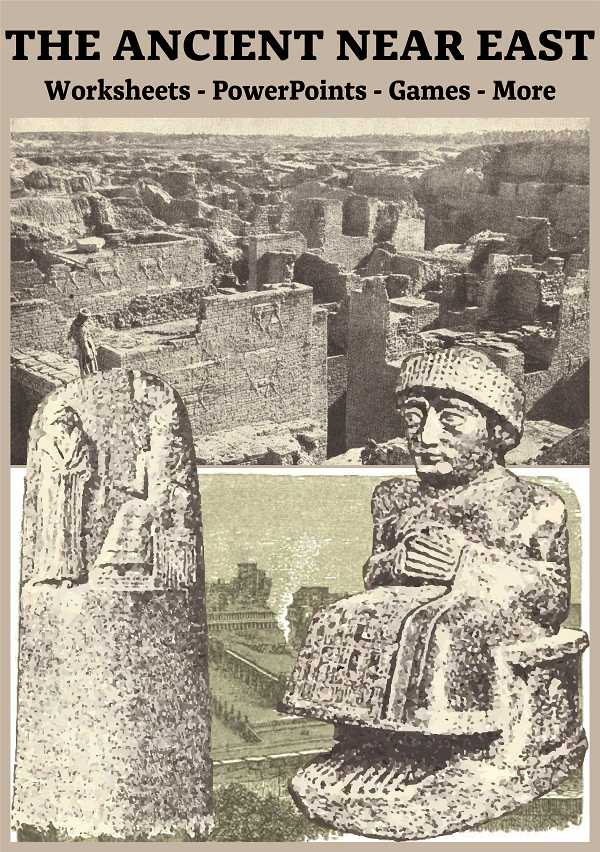 |
Ancient Near East Educational Materials |
|---|
www.studenthandouts.com > World History > Ancient Near East |
|---|
Life in the ancient Near East was characterized by a rich tapestry of cultures, civilizations, and historical periods, spanning thousands of years and encompassing diverse regions. While conditions varied depending on time and place, here are some common aspects of life in the ancient Near East. Agriculture: Agriculture played a central role in the economies of many ancient Near Eastern civilizations. People cultivated crops such as wheat, barley, millet, and various fruits and vegetables. Irrigation systems were often developed to manage water resources in arid regions.
Agriculture: Agriculture played a central role in the economies of many ancient Near Eastern civilizations. People cultivated crops such as wheat, barley, millet, and various fruits and vegetables. Irrigation systems were often developed to manage water resources in arid regions.City-States: Urbanization was a hallmark of the ancient Near East. City-states, with their own governments and rulers, emerged as centers of political, economic, and cultural activity. Prominent city-states included Uruk, Ur, Babylon, Nineveh, and Ashur, among others. Trade and Commerce: The ancient Near East was a hub of trade, facilitated by its geographic location between Asia, Africa, and Europe. Trade routes like the Silk Road connected distant regions, leading to the exchange of goods, ideas, and technologies. Religion: Religion played a central role in the lives of ancient Near Eastern people. Many civilizations in the region had pantheons of gods and goddesses, and temples were important religious and cultural centers. Prominent religions included Mesopotamian polytheism, Egyptian religion, and the worship of various gods and goddesses in the Levant. Writing Systems: Writing systems developed independently in different parts of the ancient Near East. Notable scripts included cuneiform (used in Mesopotamia), hieroglyphics (in Egypt), and the Proto-Sinaitic script (an early precursor to the alphabet). These scripts were used for record-keeping, literature, and religious texts. Monuments and Architecture: The ancient Near East is known for its impressive architectural achievements, including ziggurats (stepped pyramids), temples, palaces, and city walls. These structures served both practical and religious purposes. Social Hierarchy: Society in the ancient Near East was typically hierarchical, with rulers, nobles, priests, and a laboring class. Slavery was common in many civilizations, and social mobility was often limited. Law Codes: Some of the earliest known legal codes were established in the ancient Near East. Notable examples include the Code of Hammurabi in Babylon and the Hittite laws. These codes codified rules of behavior and justice. Art and Culture: The ancient Near East produced a rich cultural heritage, including art, literature, and music. Examples include Sumerian cuneiform literature, Egyptian hieroglyphic inscriptions, and Babylonian mathematics. Conflicts and Empires: The region experienced periods of conflict and the rise and fall of various empires, including the Akkadian Empire, Assyrian Empire, Babylonian Empire, Persian Empire, and Egyptian dynasties. These empires often vied for control of territory and resources. Innovations: The ancient Near East was home to numerous innovations, including the wheel, the plow, the calendar, and advancements in mathematics, astronomy, and medicine. Migrations and Interactions: The movement of peoples and the interactions between different cultures were significant features of life in the ancient Near East. This led to the diffusion of ideas, technologies, and cultural practices. It is important to hold in mind that the ancient Near East was a region of great diversity, and life varied considerably over time and across different civilizations. The region's history includes the rise and fall of powerful empires, the development of complex societies, and the contributions of these ancient cultures to the foundations of human civilization. We know that our free teaching materials--including printables, puzzles, outlines, PowerPoints, worksheets, maps, pictures, DBQs, and more--will aid you and your high school students' exploration of this fascinating subject in your World History class. |
www.studenthandouts.com > World History > Ancient Near East |
|---|






